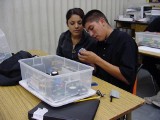The Rules
- One minute will be allowed for setup and calibration before
each round.
- The LEGO robot must fit within the 18 x 18 cm starting box
and weigh a maximum of 500 grams (the weight effectively excludes
Handy Board robots).
- The maximum number of motors is two. Servo motors are not
allowed.
- The robot must start behind one of the two central lines.
- The team operator is only allowed to place the robot on the
board and to push its starting button when told to do so.
- The robot must beep when the button is pushed and start no
sooner than 5 seconds after the button is pushed. (to allow
the operator to remove his/her hand and step back).
- The robot must move during the first 35 seconds after the
starting button is pushed, and then stop. Robots that donÕ move
or stop after 35 seconds will forfeit the round.
- The robot winning two out of three rounds is the winner.
- During the round the first robot to touch the outer line loses
the round; if neither robot goes out after 35 seconds, the one
with the red power button farthest from an outer line wins.
Game
Board Description:

- The board is a 4 x 4 foot white enamel masonite board, the same material
as used in Botball.
- The board is edged with 1x2" pine furring strips (only needed for protection
and for the Line Running Challenge).
- The lines are made with standard 19 mm (3/4" black electrician's tape
except for the two lines in the center, which are light green paper, attached
with scotch tape. In some places the tape may be two layers thick (where
tape overlaps).
- The two centered lines are 21.6 cm long and 5 cm apart .
- The sharp curves are 7.6 cm radius and broader curves are 15.2 cm radius
on the inside edges.
- The inner area is 64 cm x 64 cm and the space between parallel lines is
10 cm.
- The circled numbers are not on the board, but identify the reference lines
for the line running competition.
- The two starting boxes are 18 cm x 18 cm and 10 cm apart, equally spaced
with one edge on the inner edge of the outside straight line.
Robot Course
Construction Tips:
- Suggested method for accurate line layout: Measure and draw the inside
edges of the tape as two concentric boxes on the board, then use a compass
to draw the curves. Finally, lay the tape along the marked edges, taking
care to not stretch the tape, as it tends to shrink back to its unstretched
length.
- You should try to make the board lighting as uniform as possible, but
the entrants are responsible for calibrating out the local lighting effects
on their sensors.
Sharing the Results:
If you would like to share the results of your runs or competition, please feel
free to send Terry Grant with
your data and other information regarding the challenge, or if you have any
questions about what to send.








